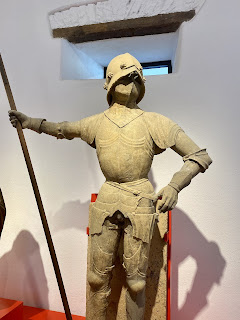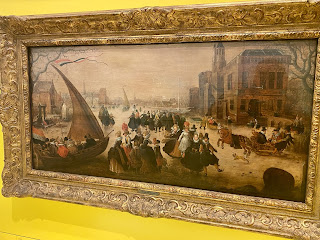Das Simeonstift war eine mittelalterliche Anlage mit Kreuzgang zu Ehren des Heiligen Simeon, der als Eremit in der Porta Nigra lebte (https://fraumb-far-far-away.blogspot.com/2021/10/trier-2021-das-schwarze-tor-black-gate.html?m=0). Stift und Kirche wurden 1802 durch Napoleon aufgelöst und in den Räumlichkeiten befindet sich nun das Museum.
An der Aussenmauer fiel mir zuerst eine Gedenktafel für die im späten Mittelalter bis in die Renaissance hinein ermordeten Frauen und Männer, denen Hexerei vorgeworfen wurde. Ein sehr dunkler Teil unserer Geschichte, der sehr selten mehr als nur im Nebensatz erwähnt wird. Auch hier gibt es eine Inschrift und ein Relief, dass auf den Namensgeber verweist und eine große Statue von Karl Marx, der allgegenwärtig ist hier, was mir positiv auffällt.
Das Museum ist in fünf Bereiche unterteilt, beginnen wir mit dem Trebeta-Saal, der dem sagenhaften Gründer der Stadt, dem assyrischem Königssohn Trebeta gewidmet ist, der angeblich bereits 1300 Jahre vor den Römern die Stadt gründete. Es gibt ein Ölbild und Statuen vom Trebeta-Brunnen und dem Roten Haus vom Marktplatz.
Gefallen haben mir die vielen Sitzgelegenheiten, und auf jedem Sitzkissen eine Frage und auf der Rückseite die Antwort. Es gibt ein Trier-Kino mit allerlei filmischen Dokumenten über die Stadt und auch sonst einige Möglichkeiten, Dinge zu be-greifen. Ich habe mich fürs puzzlen entschieden.
Im roten Saal geht es um die Stadtgeschichte Triers. In mehren Räumen werden Stadtmodelle, Kunst- und Alltagsgegenstände repräsentiert, die einen Einblick in Alltag und Feiertag der Menschen von Trier geben.
Im gelben Saal geht es um Wirtschaft, Handwerk, Politik, Sport, Religion, Kunst, Tourismus, Verkehr. Mir gefällt die Presentation, sie ist modern, hat ein gutes Design.
Dann gibt es den Saal „Stifter im Stift“. Hier werden alle Schenkungen von Trierer Bürgern versammelt, Gemälde, Skulpturen, eine Sammlung von asiatischen Miniaturen und eine Ausstellung von Textilien aus verschiedenen Jahrhunderten.
Die Gemäldegalerie zeigt einige wenige aber dafür sehr schöne Gemälde und außerdem kann man/frau/kind hier selber puzzeln. Das hat mir sehr gefallen.
Die temporäre Ausstellung widmet sich dem Thema „Jüdisches Leben in Trier“ und zeigt Geschichte und Gegenwart der jüdischen Gemeinde der Stadt und wo man im Stadtgebiet noch Spuren jüdischen Lebens finden kann.
Zum Schluss noch der Kreuzgang mit barocken Statuen des Bildhauers Ferdinand Tietz, die auch im Palastgarten des kurfürstlichen Palais zu bewundern sind.
Zum Abschluss noch ein großes Wandpuzzel puzzeln und dann brauche ich einen Kaffee, im Pappbecher, für unterwegs, denn nun ist mein Test nicht mehr gültig.
English version below
I did get up early to make sure my negative Covid test is still valued when I visit the Porta Nigra. It turned out no test was needed. Now I’m done with the Porta, got still one and a half hours of valued test left over and are standing in front of the city museum - exactly! I’m already in.
The Simeonstift (a collegiate church) was a medieval setting with a cloister to honour the hermit monk Simeon who lived in the Porta Nigra (https://fraumb-far-far-away.blogspot.com/2021/10/trier-2021-das-schwarze-tor-black-gate.html?m=0). The Stift and church have been closed by Napoleon in 1802 and the building is housing the city museum today.
First thing I noticed on the outer wall was a memorial plate for all from the late medieval age until the renaissance age murdered women and men who have been accused of witchcraft. A dark chapter in our history that very seldom is mentioned in more details than a side note. And here too we find a plate and a relief of the name patron and a big statue of Karl Marx who is present everywhere in Trier, what I like much.
The museum is divided into five sections, let’s start with the Trebeta room, dedicated to the legendary founder of the city Trebeta, an Assyrian son of king Ninus. The tale is that he founded Trier 1300 years before the Romans arrived. There is a big painting on canvas of him and statues of the Trebeta fountain and the Red House, both located at the market place.
I liked much the the stools everywhere, they had a round cushion on top with a question on and the answer is found when you turn it around. There is a cinema where many movie sequences about Trier’s history are shown and there have been other things you could touch, I chose jigsaw puzzle.
There is the Red Room, a line of several room displaying the history of Trier with models of the city and item of everyday use and artwork and so we get a good impression about common and holidays of the people living there.
There is the Yellow Room, now it’s all about industry, transportation, culture, sports, religion, politics and tourism. It’s a well designed place with a fresh appearance.
There is a place called ‘Stifter im Stift’ dedicated to the donors and patrons who made the museum possible. There are paintings and sculptures and an impressive collection of Asian miniatures and a collection of textiles art with dresses and robes during the centuries.
The gallery of paintings show a few but very lovely items and you get the chance to puzzle one of the pictures you saw hanging on the wall. I liked that much.
There is a temporary exhibition about the past and present of the Jewish life in Trier and shows where in the city can be found traces of it.
At the end the cloister with a display of baroque statues by Ferdinand Tietz which can been seen also in palace garden of the electoral palace (Kurfürstliches Palais).
At the very end I need to solve a big jigsaw puzzle on the wall and then I’m up for a coffee, in a paper cup on the go, since my test isn’t valued anymore.
-








































































Keine Kommentare:
Kommentar veröffentlichen